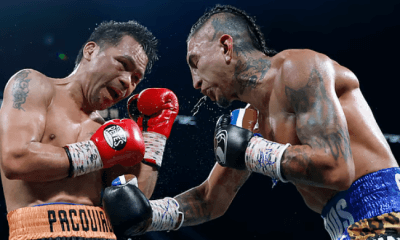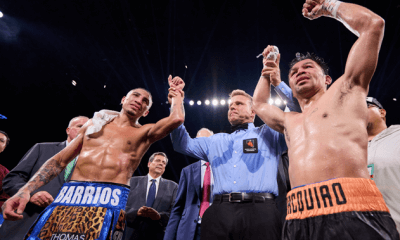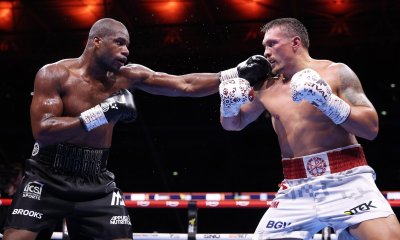Articles of 2007
Deirdre Gogarty: No titillating sideshow
Former Women’s International Boxing Federation featherweight champion Deirdre Gogarty will always be remembered for her epic battle against Christy Martin on the pay-per-view televised undercard of the second Mike Tyson-Frank Bruno fight in March 1996.
Although Gogarty lost a six-round decision to Martin, the fight put women’s boxing on the map. Not long afterwards, Martin appeared on the cover of Sports Illustrated and it looked as if women’s boxing had finally achieved mainstream respectability.
Sadly, the momentum didn’t last long. Gogarty, who had turned pro in London in June 1991, would fight on until January 1998, when she lost a ten-round decision to Beverly Szymanski in Atlantic City.
Along the way, she won the aforementioned title with a unanimous decision over the previously undefeated Bonnie Canino in New Orleans in March 1997. Her final ring ledger was 19-6-2 (17 KOS).
“A lot of people remember the Martin fight,” said the now 37-year-old Gogarty. “Most people expected me to get knocked out in a couple of rounds. I got ten days notice, and arrived in Las Vegas a few days before the fight. I was left out of the hoopla, but got my share later on. It was a good thing for women’s boxing. For the first time people talked about it as a legitimate sport.”
When a teenage Gogarty developed a passion for the sport, the thought of women fighting each other was incomprehensible to even the most ardent current fans.
While living in her native Drogheda, Ireland, Gogarty was blown away by the passion and artistry of former WBA featherweight champion Barry McGuigan, who also hailed from her native country.
“I always loved boxing, but watching him really made me want to do it,” said Gogarty. “I saw him win the title from Eusebio Pedroza on my grandmother’s TV. I had the sound turned down and she thought I was watching ballet. I was totally fascinated. The whole magic of boxing was so exciting to me.”
Having grown up in a home where both of her parents were dentists, one can only wonder how Gogarty developed such an esoteric interest. Even she doesn’t have that answer, although she does say that once she walked into the Drogheda Boxing Club nothing could dissuade her from pursuing her dream.
“I definitely felt like an outcast,” said Gogarty. “At first I got knocked around a bit, and few people expected me to come back. But I kept going forward and was willing to take the hits to earn the respect.”
When it came to boxing, Gogarty was very mum around her parents. They would have rather seen her choose much more conventional pursuits.
“They didn’t like it all,” she explained. “I didn’t tell them much. I downplayed everything. I wanted them to think I just boxed for the workout.”
With few people willing to train her, Gogarty was lucky to have an ally in Pat McCormack, a former British welterweight champion.
“He said if I was his daughter he’d want me to know how to defend myself,” said Gogarty.
McCormack taught her enough for her to embark on a pro career at a time when women’s boxing was still being viewed as a titillating sideshow. Through a British referee named Paddy Sower, Gogarty was introduced to American Beau Williford, who trained her for much of her pro career.
“At first I said I didn’t know about women’s boxing, and I didn’t want to learn,” said Williford. “But Paddy put the pressure on me to train her. He reminded me that he did a lot of favors for me, so I felt indebted to him. She was forced on me.”
Around that time, Williford was very friendly with writer Jerry Boyd, who as F.X. O’Toole wrote the story on which the Academy Award winning film “Million Dollar Baby” was based.
With the exception of the fictional fighter’s dysfunctional family, as well as the movie’s tragic ending, Williford thinks that much of the film was based on his relationship with Gogarty.
“Jerry was always calling me about Deirdre,” recalled Williford. “When she fought in Las Vegas he said, ‘Boy, can that girl fight!’”
Not surprisingly, the single Gogarty, who, like Williford, resides in Lafayette, Louisiana, is a big fan of the film. “I loved it,” she said. “I would have liked to see more training, but overall it was a great movie and very good for the sport. Her (Maggie Fitzgerald, the character played by Hilary Swank) getting hurt was difficult, but it was a freak accident.”
Like the fictional Fitzgerald, people might be more than a bit surprised about Gogarty’s personal history. Her great uncle was the first president of the Irish Senate.
Irish freedom fighter Michael Collins, who was portrayed by Liam Neeson in the 1996 film of the same name, spent the last night of his life in her uncle’s home.
And Deirdre is accomplished in her own right in more areas than boxing. In the late eighties and early nineties she designed and created characters for the beginning and end scenes of the “Ninja Turtle” television series.
Today she owns her own graphic design business, which is appropriately called Knockout Graphics. She also creates stunning shadow boxes of famous fighters, many of which she has donated to be raffled off at the International Boxing Hall of Fame and the Dr. Theodore Atlas Foundation’s annual fundraiser.
Her subjects have included Micky Ward, Larry Holmes and Sugar Ray Leonard.
She also works part-time as an administrator for the Louisiana Boxing and Wrestling Commission, and, along with Williford, coaches youngsters at least four days a week at the Ragin’ Cajun Boxing Club in Lafayette.
Asked if her pupils realize what an experienced coach they have, she says, “The kids take me very seriously. They are smart enough to know they have someone who knows what they are doing.”
Of all of her activities, Gogarty considers coaching kids to be the most personally rewarding. Still a maniacal boxing fan, she greatly admires Oscar De La Hoya “because his accomplishments are outstanding and he is a great ambassador for the sport.”
She also is high on Ward, Arturo Gatti, Marco Antonio Barrera and Erik Morales.
A bit disheartened by the fact that female boxing is not much bigger now than it was when she was fighting, Gogarty believes that with more television exposure the sport would garner a new generation of fans.
She says Laura Serrano, who stopped her in seven rounds in Las Vegas in April 1995, is the best all-around female fighter she ever saw because “she fought everybody and beat everybody.”
Number two in her book is Lucia Rijker, who she described as having “extraordinary power and skills.”
Her number three position is a tie between Christy Martin and Chevelle Hallback. Hallback, who she says “is strong, fast and tough,” while Martin was “one of the few who could knock you out with one punch.”
Even if Gogarty believed that she belonged in the top five, you just know that she would be much too modest to admit it.
Looking back on her career, Gogarty has just one regret. “I would have liked to defend my title in Ireland,” she said. “But I got a shoulder injury and had to retire. I tried several comebacks, but all of them were cancelled.
“Maybe I could have accomplished more,” she continued, “but I got my world title and I wanted that more than anything. Some people’s careers are cut short before they have a chance to even realize that goal.”
-

 Featured Articles3 weeks ago
Featured Articles3 weeks agoThe Hauser Report: Zayas-Garcia, Pacquiao, Usyk, and the NYSAC
-

 Featured Articles2 weeks ago
Featured Articles2 weeks agoOscar Duarte and Regis Prograis Prevail on an Action-Packed Fight Card in Chicago
-

 Featured Articles1 week ago
Featured Articles1 week agoThe Hauser Report: Cinematic and Literary Notes
-

 Book Review4 days ago
Book Review4 days agoMark Kriegel’s New Book About Mike Tyson is a Must-Read
-

 Featured Articles4 weeks ago
Featured Articles4 weeks agoManny Pacquiao and Mario Barrios Fight to a Draw; Fundora stops Tim Tszyu
-

 Featured Articles4 weeks ago
Featured Articles4 weeks agoArne’s Almanac: Pacquiao-Barrios Redux
-

 Featured Articles3 weeks ago
Featured Articles3 weeks agoRemembering Dwight Muhammad Qawi (1953-2025) and his Triumphant Return to Prison
-

 Featured Articles4 weeks ago
Featured Articles4 weeks agoOleksandr Usyk Continues to Amaze; KOs Daniel Dubois in 5 One-Sided Rounds













